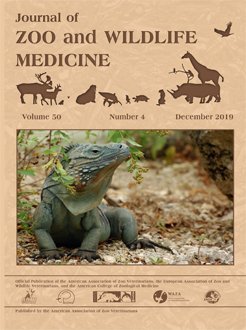Causes of morbidity and mortality and a survey of infectious disease agents were collated from wild and colony-raised endangered Amargosa voles (Microtus californicus scirpensis). Six voles from the wild and 295 voles in the captive-breeding colony were included in the study upon identification of an infectious agent during screening, identification of clinical signs of disease, or finding a pathological condition or infectious agent on necropsy. Findings included 28 significant or incidental pathological conditions of seven organ systems and 19 parasitic, viral, bacterial, or fungal agents. Several voles captured in the wild had fungal osteomyelitis of the tail that disseminated systemically in a vole brought from the wild to the colony and may have been caused by a Penicillium sp. Three voles reintroduced from the colony to the wild experienced inanition and subsequent severe hepatic and moderate renal tubular lipidosis. The most common significant pathological conditions in colony-reared voles were chronic interstitial nephritis with proteinosis; cardiomyopathy; trichobezoars that, in intestines or cecocolic junctions, sometimes induced local rupture or infarction with peritonitis; multifocal gastrointestinal ulceration and colibacillosis; acute renal tubular necrosis or nephritis; sepsis; hepatic and renal lipidosis; molar apical elongation sometimes progressing to invasion of the calvarium; and mammary tumors. Uncommon diagnoses included intervertebral disc disease; microvascular dysplasia; and multifocal bacterial abscessation. Common or clinically important infectious agents included Demodex sp. mites in hair follicles, Demodex sp. in esophageal mucosa, and an outbreak of tropical rat mites thought to have been introduced via the straw bedding; gastrointestinal Helicobacter sp.; attaching and effacing Escherichia coli; and Citrobacter braakii, a possible zoonotic bacterium. This survey of species-specific diseases and pathogens was possible because the established health surveillance program that is part of the species recovery plan allowed for monitoring of voles throughout the duration of their natural life spans in captivity.
How to translate text using browser tools
9 January 2020
DISEASE AND PATHOLOGICAL CONDITIONS OF AN ENDANGERED RODENT, MICROTUS CALIFORNICUS SCIRPENSIS, IN A CAPTIVE-REARING FACILITY AND IN THE WILD
Janet Foley,
Nora Allan,
Risa Pesapane,
Amanda Johnson,
Leslie Woods,
Laurie Brignolo,
Abigail Luce,
Deana L. Clifford,
Denise M. Imai
ACCESS THE FULL ARTICLE
Amargosa vole
endangered species
Microtus californicus scirpensis
mites
rodent
trichobezoar





